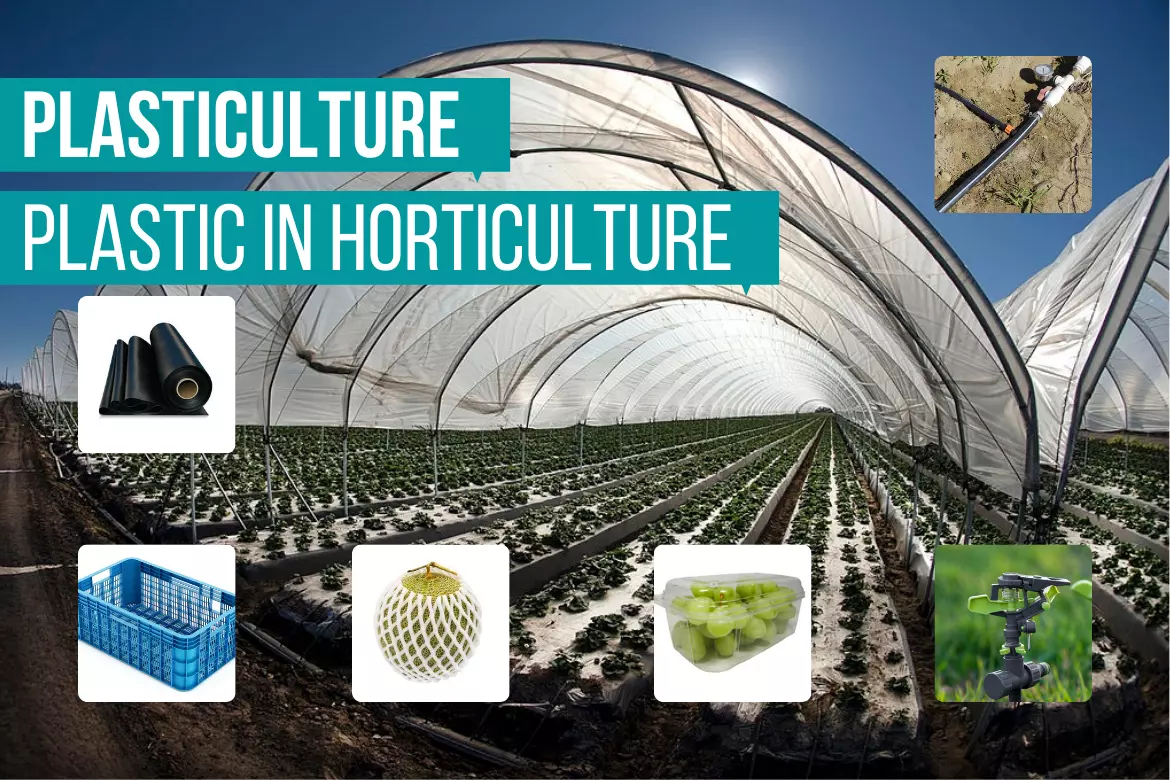Table of Contents
Introduction
Plasticulture is defined as the application of plastics / polymer in agriculture, horticulture, water management and related areas.
Horticulture employs plastic in almost all of its activities from seed packaging, planting, propagation, field mulching, irrigation, crop harvesting, fruit packaging, transportation, and preservation of end product.
Fibre/polymers have physical, chemical, mechanical and thermal properties which have enabled it to its widespread use in agriculture field. They have good tensile strength and elongation property, heat preservation behaviour, good water permeability, good photopermeability, good thermal stability, reusable nature.
Plasticulture is one of the most useful indirect agricultural inputs which hold the promise to transform agriculture and assist in bringing the dawn of the “Second Green Revolution”.
Few of the indirect agricultural inputs of plasticulture are moisture conservation, efficient and precise application of water and nutrients, controlled environment agriculture – polyhouse, and plant protection. Additionally, plasticulture has also contributed hugely in providing innovative packaging solutions for storage and transportation of fruits and vegetables.
Types of plastic used in plasticulture
Plastic materials such as polyethylene (PE), polypropylene (PP), ethylene-vinyl acetate copolymer (EVA), polyvinyl chloride (PVC), polycarbonate (PC), poly methyl 1-methacrylate (PMMA), glass fiber reinforced polyester are widely used in agriculture.
The types of plastics used in plasticulture can be roughly divided into two categories.
Commodity plastic, which is the majority of plastic type produced by the petro chemical industry. Following are some of the types of commodity plastic:
Polyethylene (PE) : Low Density PE (LDPE), High Density PE (HDPE), Linear Low Density PE (LLDPE)
Polypropylene (PP)
Polyvinyl Chloride (PVC)
Polystyrene
Engineering and Specialty plastics, are the type of plastics which provide enhanced mechanical and thermal properties when compared to commodity plastic. These plastics are used for very specific purposes in agriculture. Some of the examples of this kind of plastic are as follows:
Styrene derivatives (PS/ EPS and SAN/ABS)
Polycarbonate
Polymethyl methacrylate
Poly oxy methylene plastics
Use of biobased plastic nets-poly amino acids, polysaccharide derivatives, polyhydroxybutyrate, polycaprolactone, polyhydroxylalkanoate, polylactic acids which are biodegradable in nature are the more advanced and safer polymers.
Advantages of Plastic over traditional materials
- Higher strength to weight ratio
- Very high flexibility, ability to be folded and rolled easily
- Impermeable to gas, water etc
- Corrosion resistant
- Chemical resistant
- Smoother surface resulting in very less friction
- Light weight , hence assists in increasing storage space and more efficient transportation and less fuel consumption while being transported
- Very durable
- Preferred hygienic method of food packaging
- Exceptional electrical and thermal insulation
- Relatively cheaper to manufacture
Various types of plasticulture applications
1.Water management
- Lining of canals, ponds and reservoirs with plastic film
- Drip and Sprinkler irrigation
- PVC & HDPE pipes used for water conveyance
- Sub-surface drainage
2. Nursery management
- Nursery bags, pro-trays, plastic plugs, coco-pits, hanging baskets, trays etc
3. Surface cover cultivation
- Soil solarisation
- Plastic mulching
4. Controlled environment horticulture
- Polyhouses
- Shade net houses
- Low tunnels, High tunnels
- Plant protection nets
5. Innovative packaging
- Plastic crates, mesh bags, net bags, bins, punnets, boxes, leno bags, unit packaging products, bio degradable packagingetc
- CAP covers, controlled atmospheric packaging (CAP) & modified atmospheric packaging (MAP)
Uses of plastic in Horticulture
Mulching
Mulching is the activity of covering the soil around the plant with materials like sawdust, compost, grass, hay, dry leaves, stones or plastic sheet to reduce the evaporation of water, prevent soil erosion, maintain soil temperature, weed control and keep the fruit clean.
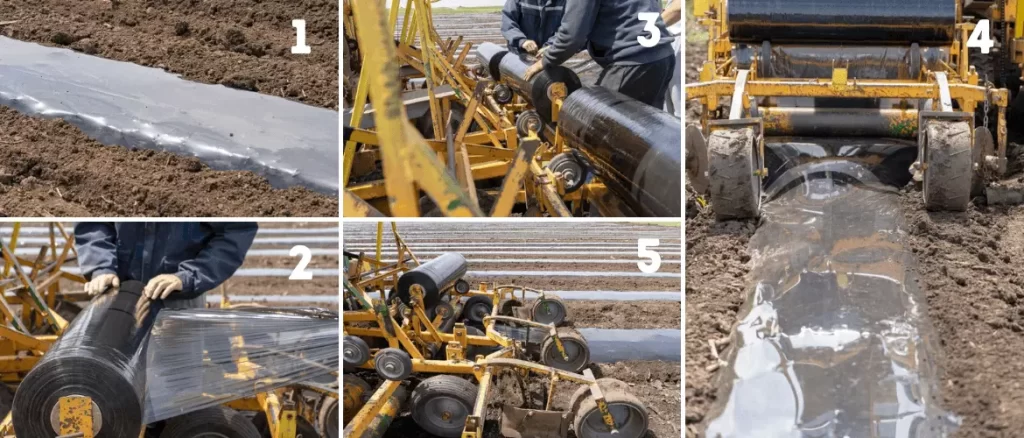
Plastic has seen a rise in being used as a mulching material. Plastic sheet acts as an excellent mulch, creating a micro-climate in the plant root zone assisting in early maturity of the crop and increasing the yield. Plastic sheet also performs exceptionally well in preventing weed growth and maintain soil moisture.
With drip irrigation and plastic mulch, fertilizers do not leach below the root zone, this ensures that nitrogen and other nutrients are only applied to the root zone. In comparison with broadcast fertilization with flood and furrow irrigation, this method greatly optimizes fertilizer utilization.
Mulches made of plastic reduce contact between fruits and vegetables with soil, reducing fruit rot and keeping produce clean.
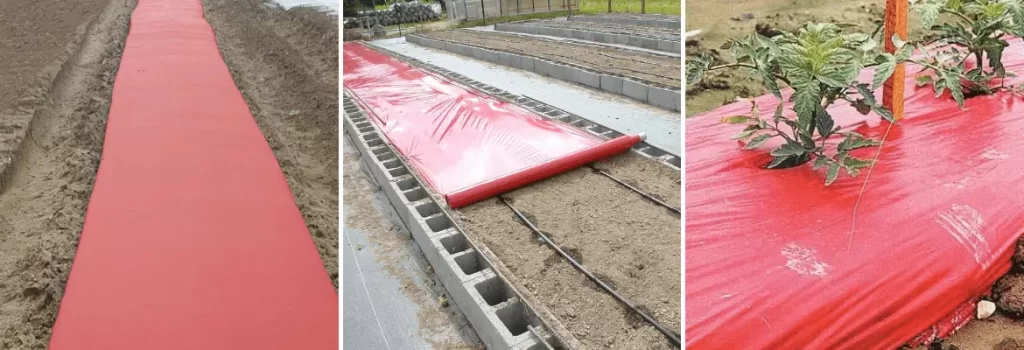
The use of plastic mulch lessens the crusting effect of rain and sunlight, as well as the number of weeds, assisting in aeration of the soil, encouraging microbial activity and increasing the effect of biofertilizers if applied.
Weed reduction eliminates root damage and increases overall plant growth.
Plastic mulch film comes in a variety of thicknesses and is chosen according to the type and age of the plant. The thickness of plastic mulch ranges from 7 to 100 microns. A plastic mulch of 25 to 50 micron thickness is preferred for medium duration crops, and a plastic mulch of 50 to 100 micron thickness is preferred for long duration crops.
LDPE (Low Density Polyethylene) and LLDPE (Linear Low Density Polyethylene) plastic covers are mostly used in mulching today. The average thickness of plastic mulch in fruit cultivation is 25 to 40 microns.
Following table shows the amount of increase in yield of vegetable plants when plastic was used as a mulching material
| CROP | YIELD ton/ha UNMULCHED | YIELD ton/ha MULCHED | INCREASE IN YIELD (%) |
|---|---|---|---|
| CABBAGE | 14.30 | 19.90 | 39.16 |
| CAULIFLOWER | 18.58 | 25.02 | 34.66 |
| TOMATO | 69.10 | 94.85 | 37.26 |
| CHILLI | 16.79 | 19.71 | 17.39 |
| OKRA | 6.91 | 8.56 | 23.88 |
| BITTER GOURD | 20.12 | 25.63 | 27.39 |
| BRINJAL | 36.73 | 47.06 | 28.12 |
| BROCCOLI | 15.64 | 25.14 | 60.74 |
| Source : Bhattacharya et al., 2018 | |||
From the table above, it is evident that the plastic mulching results in greater yields in crops.
Types of plastic mulches
Black plastic mulche
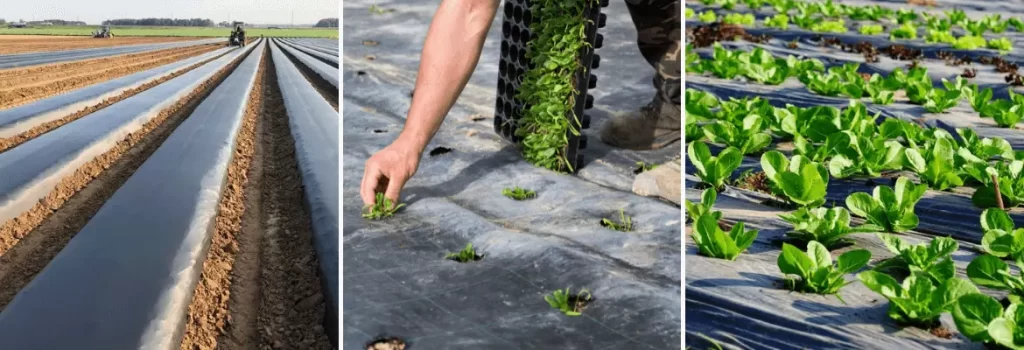
The black plastic film prevents sunlight from reaching the soil. In the absence of sunlight below the black film, photosynthesis cannot occur in soil. Therefore, it stops weed growth completely. Moisture is conserved, weed growth is controlled, and the soil temperature is raised. Black film has proven effective in plains to keep crops cool during summer.
Clear or transparent plastic mulches
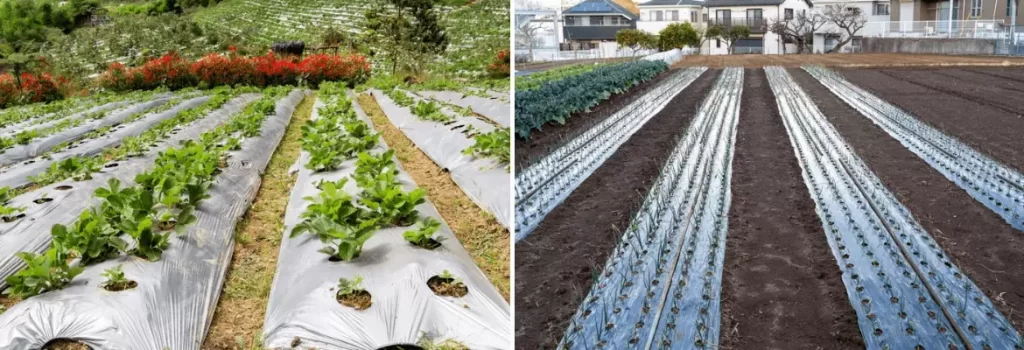
Transparent films will let sunlight pass through, which will allow weeds to grow. However, the inner side of the film can be coated with herbicide to control weed growth. In nursery raising, this application is quite successful. It allows for the solarisation of beds before seed planting, resulting in an almost 100% seed germination rate and disease-free nursery. During the winter, it is effective in raising soil temperature in hilly areas with cold climate conditions.
Two side coloured plastic mulches
Plant growers can control leaf and fruit size, colour, root development, yield, branching, plant height, the strength of stems, time of flowering, and even prevent diseases by keeping insects at bay, by using this kind of plastic mulch.
Following are some of the colour combinations in two sided plastic mulch along with the uses:
WHITE/ BLACK : Helps in cooling the soil
YELLOW/ BLACK : This plastic mulch attracts certain insects and acts as a trap. Trapping those insects results in reduction of diseases inflicted by pests.
SILVER/ BLACK : It deters some aphids and thrips. It also helps in cooling of the soil but not as much as white and black plastic mulch.
RED/ BLACK : This plastic mulch is translucent in nature, which allows radiation to pass through and keep the soil warm. Furthermore, it reflects radiation back into the plant canopy, changing the ratio of R:FR light. This results in an increase in the rate of vegetable/flower development and early fruiting. This even increases yields in some fruit and vegetable crops.
Degradable plastic mulches
PHOTODEGRADABLE plastic mulch : Over the designated mulching period, this type of plastic mulch film disintegrates under sunlight.
BIO DEGRADABLE plastic mulch : In natural environmental conditions, this type of plastic mulch film disintegrates and is incorporated into soil after mulching.
Following table shows the effect of mulching on various factors such as moisture content of the soil, weed density, and yield parameters in chilli (Capsicum annuum L).
| MULCHING METHOD | Soil moisture content (%) | Weed density (g/plot dry wt) | No. of fruits | Fruit length (cm) | Fruit width (cm) | Fruit wt(g) | Green fruit yield (kg/plant) | Green fruit yield (q/ha) | BCR : Benefit-Cost Ratio |
|---|---|---|---|---|---|---|---|---|---|
| No mulch | 10.10 | 418.41 | 55 | 12.50 | 1.97 | 7.81 | 0.433 | 144.6 | 1.63 |
| Organic mulch (6t/ha) | 12.92 | 373.97 | 68 | 11.87 | 1.67 | 6.17 | 0.419 | 139.85 | 1.52 |
| Organic mulch (9t/ha) | 13.32 | 366.08 | 60 | 12.60 | 1.33 | 5.39 | 0.504 | 167.99 | 1.48 |
| Organic mulch (12t/ha) | 14.78 | 352.82 | 71 | 12.43 | 2.03 | 8.48 | 0.278 | 198.79 | 1.62 |
| Black polythene (double coated 30micron) | 16.74 | 75.37 | 140 | 14.06 | 2.07 | 9.99 | 1.39 | 463.88 | 3.49 |
| white polythene (double coated 30 micron) | 15.22 | 82.82 | 80 | 14.02 | 1.83 | 8.86 | 0.718 | 239.12 | 1.77 |
| Black polythene (single coated 30 micron) | 15.00 | 108.92 | 120 | 14.03 | 1.73 | 7.79 | 0.945 | 314.94 | 2.91 |
| Source : kumar,2013 | |||||||||
Its very evident from the above table that plastic mulching not only resulted in increase of the yield but also increase in the size of the fruit. Compared to no mulching or other mulching methods, plastic sheet mulching managed to retain more soil moisture, reduced the number of weeds significantly and also had a higher benefit – cost ratio (which justifies the investment on plastic mulching).
Drip irrigation
Precise and regulated application of irrigation water and plant nutrients at low pressure through drippers/emitters directly into the root zone of the plant with the help of a close network of pipes is known as drip irrigation system.
Water is dripped slowly to the roots of the plant, either through the soil surface or directly on the roots. Water is delivered directly to the plant base through a narrow plastic tube.

Drip irrigation system is mostly made by using HDPE plastic. Sublines and lateral lines have wall thicknesses ranging from 0.5 to 2 mm.
Compared to conventional irrigation, labour cost in drip irrigation is very low. Drip irrigation reduces operations costs even further by eliminating activities such as field leveling.
In addition to providing uniform water distribution and maintaining moisture in the root zone, water application efficiency becomes very high with the use of reclaimed non-potable water. 40% – 70% of water can be saved.
Drip irrigation also results in efficient use of fertilizers as the amount of leaching is reduced. Almost 30% of fertilizer can be saved by this irrigation practice.
Drip irrigation is also beneficial as it assists in early maturity of the crop, helps in controlling weed population, eliminates soil erosion (especially in uneven and undulating land), and felicitates the application of saline water if needed.
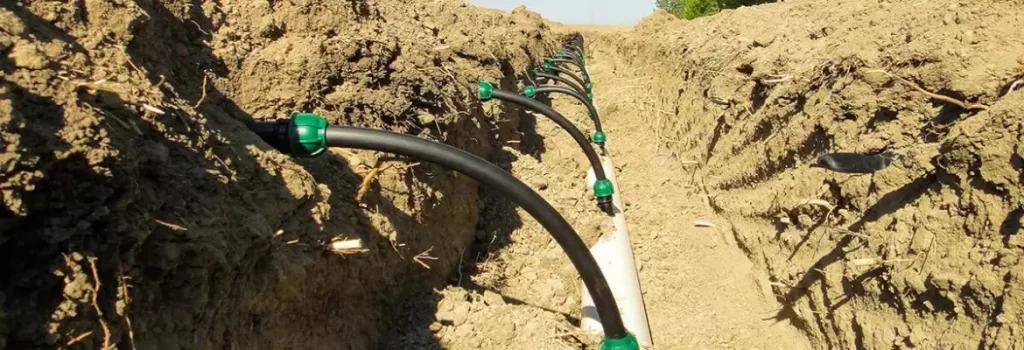
One of the most beneficial features of plastic in drip irrigation is that it is rust proof which makes it long lasting. This makes plastic, the preferred material for sub surface irrigation (inline irrigation).
In addition to the above mentioned benefits, plastic tubes used in drip irrigation are resistant to UV radiations, crack resistant, and have a wide pressure compensation range. Because of the flexible nature of plastic, the pipes can be easily installed, uninstalled, relocated and can be rolled for storage.
The following table shows the increase in yield of various crops when drip irrigation is applied:
| Crop | Yield (kg/acre) Conventional method | Yield (kg/acre) Drip method | % increase |
|---|---|---|---|
| Tomato | 576 | 894 | 55 |
| Bitter gourd | 2560 | 420 | 54 |
| Chilli | 1280 | 1600 | 25 |
| Cauliflower | 300 | 405 | 35 |
| Potato | 600 | 800 | 33 |
| Source : kumar,2013 | |||
Clearly, crops under drip irrigation tend to yield significantly more fruits (sometimes more than 50%).
Sprinkler irrigation system
The sprinkler irrigation method involves spraying irrigation water in the air through sprinklers to break it up into smaller drops before falling to the ground. Its eases the irrigation of uneven lands, and also protects the crop from frost.

The use of plastic has not only significantly increased the life of the system (due to being rust resistant), but also decreased the total cost and cost of maintenance.
Farm Pond plastic lining sheets
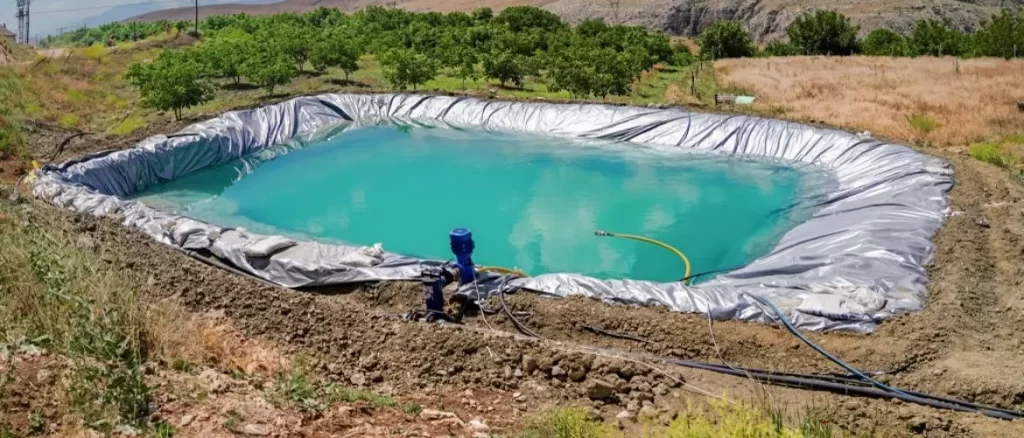
In drought-prone regions, rainfall is highly unpredictable, which makes rainwater harvesting systems dependent on storage of water. In these areas, water seepage and evaporation pose major challenges. Ponds are sealed with conventional plastic linings in order to avoid this loss of stored water. It reduces seepage in an effective and cost-effective manner.
Plastics like HDPE (high density polyethylene), PVC (polyvinyl chloride) and polyethylene are extensively used to make these pond linings.
Polyhouses / Protected cultivation
A poly house is a structure built of transparent materials, such as plastic, in which regulated climatic conditions can be simulated to stimulate crop growth. Simulations of climates are aided by equipment such as screens, heating equipment, cooling equipment, and lighting equipment. Polyethylene film, polycarbonates, and polymethyl methacrylate acrylic glass are conventional plastics used for polyhouses.
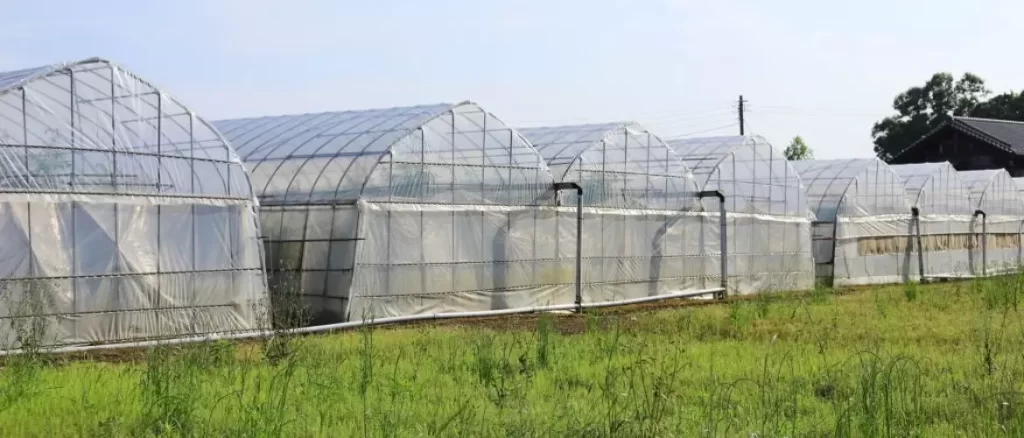
Solar radiation passes through transparent plastic and traps thermal energy inside the polyhouse, which is emitted by the objects inside the structure, a phenomenon known as “greenhouse effect”.
Before the introduction of plastic, greenhouses were made by using glass, which increased the price of constrution and maintenance. After the introduction of plastic, greenhouses are commonly also referred to as polyhouses. Plastic has greatly reduced the construction and maintenance cost of protected cultivation structures. The plastic cladding material is UV-stabilized, transparent to light, antifogging, and anti-algae.
Much like integrated farming and crop diversification, polyhouse cultivation is being heavily incentivized by the local and central government as it has removed the dependency on season to grow a specific off season crop. It has empowered the farmer to grow a particular crop in any geographical location because of the ability to create climate artificially (conducive to the growth of a particular crop).

Polyhouse technology results in superior quality crop and increased crop yield. It helps in maintenance of moisture, hence reducing the irrigation needs. Furthermore, it can be used to raise early nurseries for various crops and also harden tissue cultured plants and grafts. It also enables crop to mature early.
Following is the table showing the performance comparison of various tomato varieties under polyhouse and open field conditions.
| Varieties | Polyhouse yield (q/ha) | Open field yield (q/ha) |
|---|---|---|
| BT-117-5-3-1 | 342.00 | 115.00 |
| KT-10 | 283.60 | 117.40 |
| BT-10 | 294.00 | 111.65 |
| ArkaAlok | 260.00 | 57.90 |
| BT-12 | 302.40 | 101.00 |
| Source : Sanwalet al., 2004 | ||
By the results, we can conclude that the crop yield is more than double when crop is grown in polyhouse in controlled environment.
Various fruits such as Peach, Papaya, and Strawberry; vegetables such as cabbage, capsicum, cauliflower, chili, coriander, spinach, tomato etc ; Flowers such as carnation, gerbera, marigold, orchid and rose can easily be grown in polyhouse.
Plastic shade nets
Shade nets is a farming structure consisting of frames made from materials such as bamboo, wood, iron, etc. however, utilization of plastic has made the construction of shade net more economical and easy. It is primarily used for the raising of plant nurseries.

Structurally, it is similar to a polyhouse, and it is covered with plastic nets made by polythene threads, having different shade percentages (15 %, 35 %, 40 %, 50 % and 90 %).
It is also available in different colours like green, white, black, blue or red and in different colour combinations like green × black, black × black, green × green or white × green.

Every plant has its own specific requirements for sunlight and shade under which it thrives. Selecting the correct shade factor percentage is necessary for simulating the optimal growth conditions. Round the year cultivation can be done by controlling the atmosphere and the environment by controlling the light intensity and effective heat during the daytime.

Shade net can provide better yields during summer season and can be used to protect plant saplings from intense sunlight.
Soil solarisation using Plastic mulching
Soil solarisation is a technique used to control weed growth and soil borne pests such as bacteria, insects, nematodes and mites by using solar energy.
The solar energy is trapped by mulching the moist soil with a transparent polyethylene covering.
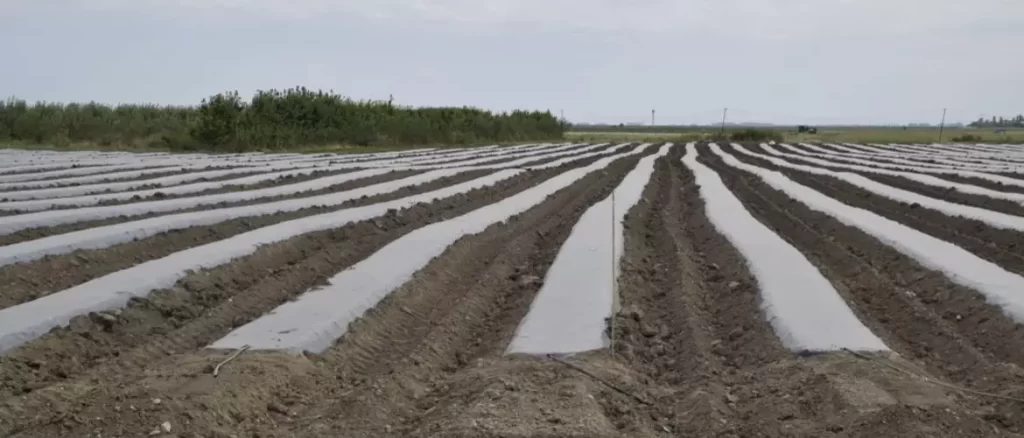
Solarisation is normally performed during the summer months when the air temperature is above 35°C. A transparent polyethylene sheet of 25 micron thickness is recommended for soil solarization.
The solar heat is trapped between the plastic sheet and the soil which helps in the decontamination of the soil. Solaralisation induces biological, chemical, and physical changes in the soil which lead to an increased growth response and long-term biological control.
The reduction of weed and pest also results in less use of weedicides/herbicides and pesticides. Furthermore, soil solerization improves the soil colour, soil structure, soil temperature and soil moisture.
Low tunnels Plastic sheets
Low tunnels allow crop production in cold climates, plains, and during rainy season. Polyethylene sheet covers have proven to be highly economical and effective in controlling plant growth conditions.
IR-grade transparent plastic with a thickness of 30 microns is usually preferred to make low tunnels.
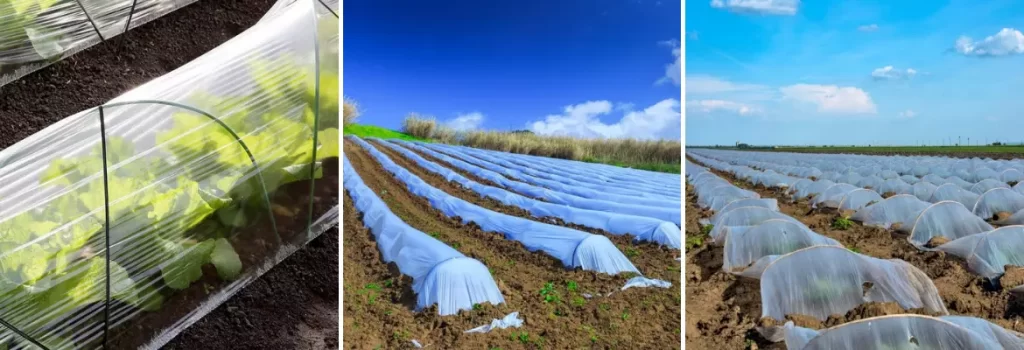
Crops grow and mature faster due to controlled conditions. The use of water is optimized as 40-50% of the water used for irrigation is saved.
Following table shows the comparison of growth and yield of cabbage under low tunnel and open field conditions.
| Character | Location-1 Low Tunnel | Location-1 Open Field | Location-2 Low Tunnel | Location-2 Open Field | Location-3 Low Tunnel | Location-3 Open Field | Average Low Tunnel | Average Open Field |
|---|---|---|---|---|---|---|---|---|
| Germination (%) | 90 | 72 | 96 | 84 | 87 | 70 | 91* | 75.3 |
| Days To Maturity Of Seedlings | 46 | 52 | 48 | 54 | 46 | 51 | 46.6* | 53.0 |
| Transplantation Survival(%) | 98 | 81 | 98 | 75 | 94 | 73 | 96.6* | 76.3 |
| Days To Head Maturity | 72 | 88 | 70 | 86 | 75 | 82 | 72.3* | 85.3 |
| No. Of Head Formed Plant (%) | 96 | 91 | 98 | 90 | 95 | 88 | 96.3* | 89.6 |
| Average Head Weight (Kg) | 0.86 | 1.01 | 0.96 | 0.98 | 0.81 | 0.82 | 0.87 | 0.93 |
| Yield(Q/Ha) | 555.79 | 652.56 | 633.34 | 587.88 | 518.02 | 562.32 | 569.0 | 600.9 |
| Yield Of Super Heads (Q/Ha) | 278.58 | 191.55 | 301.92 | 186.76 | 280.30 | 180.43 | 290.2* | 186.2 |
| Source : Saleem et al., 2014 | ||||||||
Under low tunnel, the crop yield, and crop survival both were noticeably high.
Plastic Vermi bed in organic farming
Vermibed (vermes= earthworms; bed= bedding) is made from HDPE plastic. Because of the plastic used in making vermi bed, it is completely stitch less, durable, light weight, UV stabilized and has excellent aeration control. It has got capacity to withstand environmental stress. It requires less space and can be installed anywhere.
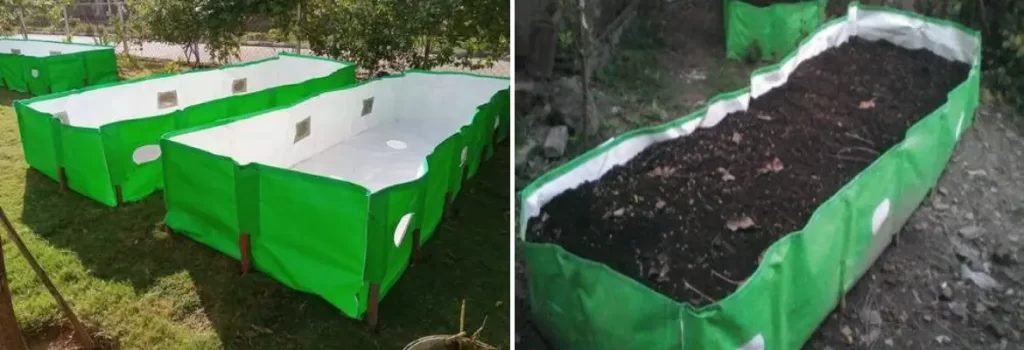
Vermi compost and vermi wash are produced in the Agriculture Vermi Bed for organic farming. It can produce almost 100 liters of vermi wash anually.
Generally, Vermi beds are 12″ x 4″ x 2″ (L x W x H) & weigh 340 grams per square meter (minimum). The bed has fourteen support pockets (40mm x 120mm) where pegs can be inserted to keep the bed upright.
Plastic uses in nursery
Plastic is extensively used in nursery operations. Some of the uses of plastics are mentioned below :
Layering and grafting : Plastic strips are used in layering and grafting in nurseries. Poly-wrappers of different colors are used in layering. Red, blue, and black poly-wrappers have a higher success rate at rooting and survival due to their ability to increase physiological activity (etiolating effect), which is essential for cell division and cell expansion.
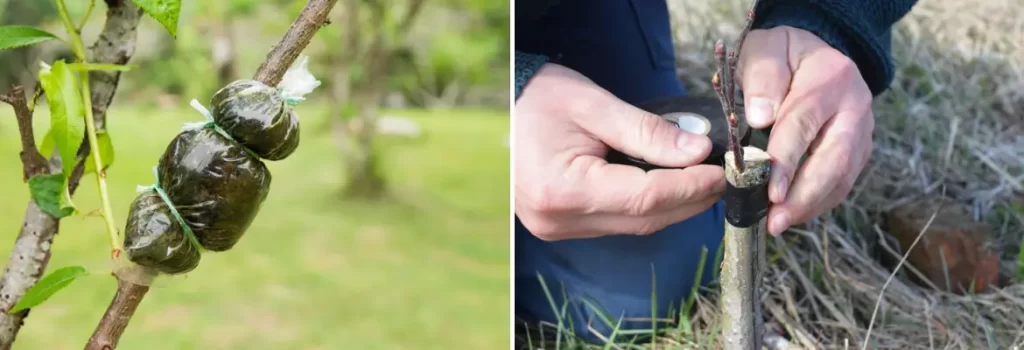
Nursery bag : Plastic is also used to make nursery bags for plants and seedlings. The nursery bags can be used in different sizes and thicknesses, depending on the crop. Plastic plant bags are cost-effective, space-saving, durable, economical, etc.

Plug tray or pro-tray : These are small trays used to grow plugs (small-sized seedlings) in potting soil in horticulture. Pro-trays are used to produce good variety of seedlings and to save space. The cone-shaped tray blocks help in the proper growth and development of the roots. Depending on the type of crop, the size of the blocks can be 1.5-2.0 m2 or 1.0-1.5 m2 in dimension. The seedlings are grown in soil less media (mixture of cocopeat, vermiculite and perlite @3:1:1).
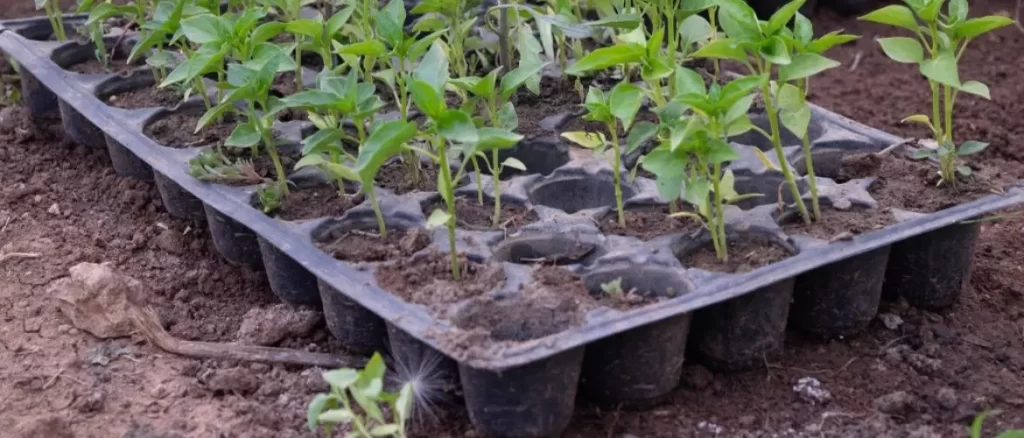
Hanging basket : These are suspended containers mostly used to plant decorative plants.

Plastic uses in Post harvest activities
A considerable portion of the fruits and vegetables produced can be lost due to mismanagement and wastage due to a lack of proper storage and transportation practices. Inefficient and bad packaging is one of the prime factors of perishable crop damage.
Plastic has enabled the designing of innovative packaging techniques which in turn has significantly reduced the wastage of produce while being transported or being stored. Plastic packaging is very significant because plastics are flexible, lightweight, cost-effective, hygienic, transparent, easy to print and mould, reusable, and increase the shelf-life of products.
The traditional methods of packaging products, especially fruits and vegetables in a jute bag and wooden crates have many disadvantages. Wooden crates sometimes are not preferred for storing soft fruits and vegetables because of their hardness and roughness. Wooden crates also have a tendency to rot or be host to undesirable bacteria and fungus. Plastics overcomes these problems.
LDPE (Low Density Polyethylene), PVC (Polyvinyl Chloride), PP (Polypropylene), LLDPE (Linear low- density polyethylene), HDPE (High Density Polyethylene) and PA (Polyamide) are typically used to make packaging.
Some of the very essential packaging entities made from plastic are listed below:
(i) Plastic trays / Plastic crates

(ii) Leno bags
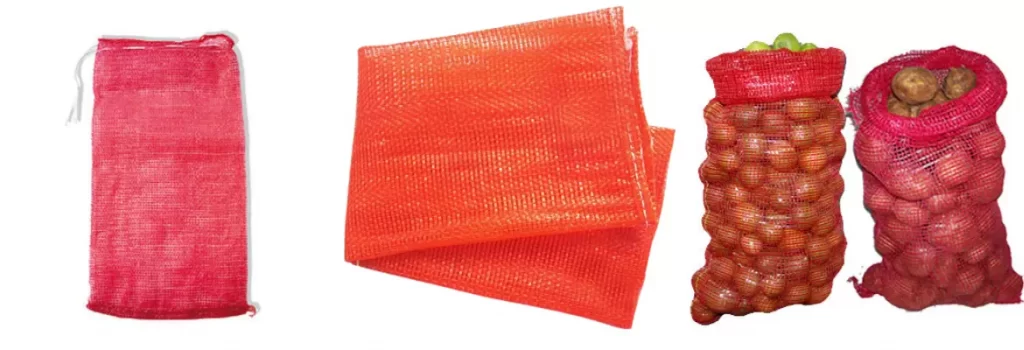
(iii) Net bags

(iv) Sleeving
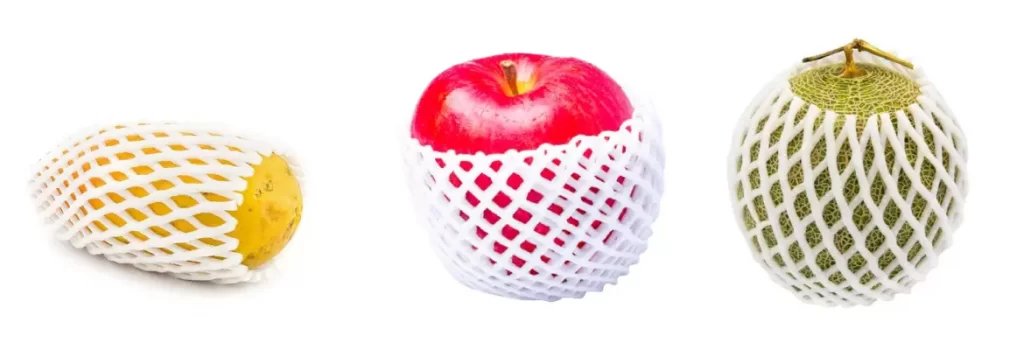
(v) Punnets
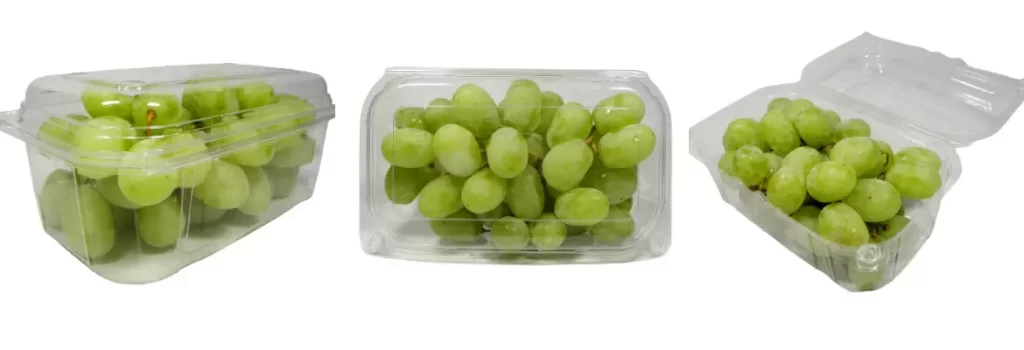
(vi) PVC cling film and tray packing


